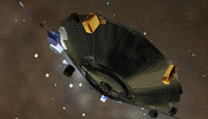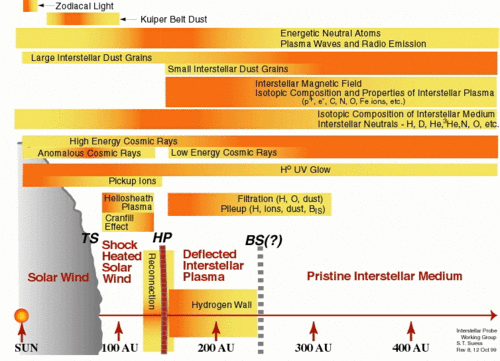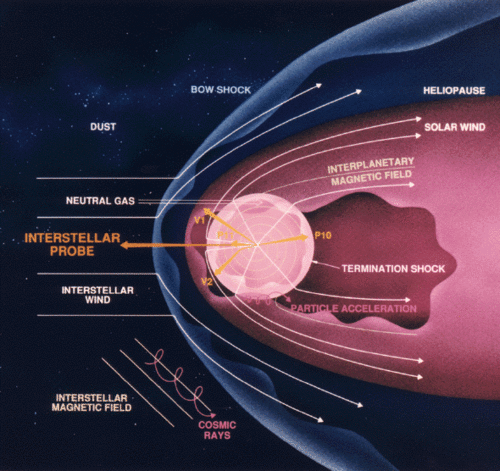Interstellar Probe (1999)

Interstellar Probe is the name of a 1999 space probe concept by NASA intended to travel out 200 AU in 15 years.[1] This 1999 study by JPL is noted for its circular 400 meters diameter, solar sail as a propulsion method (1 g/m2) combined with a 0.25 AU flyby of the Sun to achieve higher solar light pressure, after which the sail is jettisoned at 5 AU distance from the Sun.[2] Solar sails work by converting the energy in light into a momentum on the spacecraft, thus propelling the spacecraft.[3] Felix Tisserand noted the effect of light pressure on comet tails in the 1800s.[3]
The study by the NASA Jet Propulsion Laboratory, proposed using a solar sail to accelerate a spacecraft to reach the interstellar medium. It was planned to reach as far as 200 AU within 10 years at a speed of 14 AU/year (about 70 km/s, and function up to 400+ AU.[1] A critical technology for the mission is a large 1 g/m2 solar sail.[1] The probe would use an advanced radioisotope thermoelectric generator (RTG) for electrical power, Ka band radio for communication with Earth, a Delta 2 rocket for Earth launch, and a 25 kg instrument package using 20 watts.[1]
This great journey requires advanced propulsion, and the 200-kg Interstellar Probe is designed to use a 200-m radius solar sail to achieve a velocity of 14 AU/year. After exiting the heliosphere within a decade of launch, it would be capable of continuing on to ~400 AU. Interstellar Probe would serve as the first step in a more ambitious program to explore the outer solar system and nearby galactic neighborhood.
Interstellar Probe, 1999[4]
In the following years there were additional studies, including the Innovative Interstellar Explorer (published 2003), which focused on a design using RTGs powering an ion engine rather than a solar sail. Another project in this field for advanced spaceflight during this period was the Breakthrough Propulsion Physics Program which ran from 1996 through 2002.
Later examples of solar sail-propelled spacecraft include IKAROS, Nanosail-D2, and LightSail.[5] Near-Earth Asteroid Scout is a planned light sail-propelled mission.[6] For comparison, the LightSail spacecraft uses a sail 5 micron in thickness, whereas they predict a sail with 1 micron thickness would be needed for interstellar travel.[3]
Objectives

Historical view of region

See also
- Breakthrough Starshot, a fleet of small light sail spacecraft
- Innovative Interstellar Explorer
- Interstellar probe (generic)
- TAU (spacecraft) (1980s era interstellar precursor and astrometry probe)
- Stardust (spacecraft) (Believed to have collected some interstellar micro-dust)
- Interstellar Boundary Explorer (Space observatory that detects neutral atoms from beyond)
- Magsail
References
- 1 2 3 4 "Interstellar Probe". Interstellar.jpl.nasa.gov. 2002-02-05. Retrieved 2010-10-22.
- ↑ Exploration of the Outer Heliosphere and the Local Interstellar Medium: A Workshop Report (2004) PAGE 31 (about half-way down)
- 1 2 3 Propelled by light: the promise and perils of solar sailing
- ↑ NASA IP
- ↑
- ↑